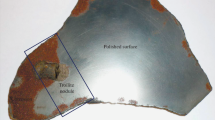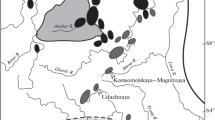Abstract
Melt inclusions were studied in chrome diopside from the Inagli deposit of gemstones in the Inagli massif of alkaline ultrabasic rocks of potassic affinity in the northwestern Aldan shield, Yakutia, Russia. The chrome diopside is highly transparent and has an intense green color. Its Cr2O3 content varies from 0.13 to 0.75 wt %. Primary and primary-secondary polyphase inclusions in chrome diopside are dominated by crystal phases (80–90 vol %) and contain aqueous solution and a gas phase. Using electron microprobe analysis and Raman spectroscopy, the following crystalline phases were identified. Silicate minerals are represented by potassium feldspar, pectolite [NaCa2Si3O8(OH)], and phlogopite. The most abundant minerals in the majority of inclusions are sulfates: glaserite (aphthitalite) [K3Na(SO4)2], glauberite [Na2Ca(SO4)2], aluminum sulfate, anhydrite (CaSO4), gypsum (CaSO4 × 2H2O), barite (BaSO4), bloedite [Na2Mg(SO4)2 × 4H2O], thenardite (NaSO4), polyhalite [K2Ca2Mg(SO4)4 × 2H2O], arcanite (K2SO4), and celestite (SrSO4). In addition, apatite was detected in some inclusions. Chlorides are probably present among small crystalline phases, because some analyses of aggregates of silicate and sulfate minerals showed up to 0.19–10.3 wt % Cl. Hydrogen was identified in the gas phase of polyphase inclusions by Raman spectroscopy. The composition of melt from which the chrome diopside crystallized was calculated on the basis of the investigation of silicate melt inclusions. This melt contains 53.5 wt % SiO2, considerable amounts of CaO (16.3 wt %), K2O (7.9 wt %), Na2O (3.5 wt %), and SO3 (1.4 wt %) and moderate amounts of Al2O3 (7.5 wt %), MgO (5.8 wt %), FeO (1.1 wt %), and H2O (0.75 wt %). The content of Cr2O3 in the melt was 0.13 wt %. Many inclusions were homogenized at 770–850°C, when all of the crystals and the gas phase were dissolved. The material of inclusions heated up to the homogenization temperature became heterogeneous even during very fast quenching (two seconds) producing numerous small crystals. This fact implies that most of the inclusions contained a salt (rather than silicate) melt of sulfate-dominated composition. Such inclusions were formed from salt globules (with a density of about 2.5 g/cm3) occurring as an emulsion in the denser (2.6 g/cm3) silicate melt from which the chrome diopside crystallized.
Similar content being viewed by others
References
A. M. Korchagin, “Inagli Vermiculite-Phlogopite Deposit,” Izv. Akad. Nauk SSSR, Ser. Geol., No. 8, 86–97 (1966).
A. M. Korchagin, “Inagli Alkaline Ultrabasic Massif, Southern Yakutia,” Izv. Akad. Nauk SSSR, Ser. Geol., No. 7, 49–59 (1972).
A. M. Korchagin, Inagli Pluton and Its Mineral Resources (Nedra, Moscow, 1996) [in Russian].
R. A. Oktyabr’skii and A. M. Korchagin, “’siberian Emerald’ (History of Discovery and New Data),” Vestn. Dal’nevost. Otd. Ross. Akad. Nauk, No. 4, 29–36 (2000).
V. B. Naumov, V. I. Kovalenko, M. I. Kuz’min, et al., “Thermometric Study of Melt Inclusions in Topaz from Topaz-Bearing Quartz Keratophyres (Ongonites),” Dokl. Akad. Nauk SSSR 199(3), 681–683 (1971).
N. P. Ermakov, “On Primary-Secondary Inclusions in Minerals,” Mineral. Sb. L’vovsk. Geol. Ob-va, No. 3, 23–27 (1949).
P. Dhamelincourt, J.-M. Beny, J. Dubessy, and B. Poty, “Analyse d’inclusions fluids a la microsonde MOLE a effet Raman,” Bull. Mineral. 102, 600–610 (1979).
J. Konnerup-Madsen, J. Dubessy, and J. Rose-Hansen, “Combined Raman Microprobe Spectrometry and Microthermometry of Fluid Inclusions in Minerals from Igneous Rocks of the Gardar Province (South Greenland),” Lithos 18, 271–280 (1985).
S. H. Bottrell, L. P. Carr, and J. Dubessy, “A Nitrogen-Rich Metamorphic Fluid and Coexisting Minerals in Slates from North Wales,” Mineral. Mag. 52, 451–457 (1988).
A. Peretti, J. K. Dubessy, J. Mullis, et al., “Highly Reducing Conditions during Alpine Metamorphism of the Malenco Peridotite (Sondrio, Northern Italy) Indicated by Mineral Paragenesis and H2 in Fluid Inclusions,” Contrib. Mineral. Petrol. 112, 329–340 (1992).
M. Fu, T. A. P. Kwak, and T. P. Mernagh, “Fluid Inclusion Studies of Zoning in the Dachang Tin-Polymetallic Ore Field, People’s Republic of China,” Econ. Geol. 88, 283–300 (1993).
R. J. Bakker and M. A. Elburg, “A Magmatic-Hydrothermal Transition in Arkaroola (Northern Flinders Ranges, South Australia): From Diopside-Titanite Pegmatites to Hematite-Quartz Growth,” Contrib. Mineral. Petrol. 152, 541–569 (2006).
J. Dubessy, M. Pagel, J.-M. Beny, et al., “Radiolysis Evidence by H2-O2 and H2-Bearing Fluid Inclusions in Three Uranium Deposits,” Geochim. Cosmochim. Acta 52, 1155–1167 (1988).
D. Derome, M. Cathelineau, T. Lhomme, and M. Cuney, “Fluid Inclusion Evidence of the Differential Migration of H2 and O2 in the McArthur River Unconformity-Type Uranium Deposit (Saskatchewan, Canada). Possible Role on Post-Ore Modifications of the Host Rocks,” J. Geochem. Explor. 78–79, 525–530 (2003).
V. L. Barsukov and B. N. Ryzhenko, “Temperature Evolution of Pore Solutions in Equilibrium with Rocks of Various Silica Contents,” Geol. Rudn. Mestorozhd., No. 3, 208–226 (2001) [Geol. Ore Dep. 43, 184–201 (2001)].
B. N. Ryzhenko and N. I. Kovalenko, “Experimental Determination of the Redox Potential of the Rock-Water System. 2. The Granite-Water System at 400–450°C and 1 kbar,” Geokhimiya, No. 5, 547–553 (2003) [Geochem. Int. 40, 499–507 (2002)].
B. E. Nesbitt and W. C. Kelly, “Magmatic and Hydrothermal Inclusions in Carbonatite of the Magnet Cove Complex, Arkansas,” Contrib. Mineral. Petrol. 63, 271–294 (1977).
E. Y. Anthony, T. J. Reynolds, and R. E. Beane, “Identification of Daughter Minerals in Fluid Inclusions Using Scanning Electron Microscopy and Energy Dispersive Analysis,” Am. Mineral. 69, 1053–1057 (1984).
V. B. Naumov, I. P. Solovova, V. I. Kovalenko, et al., “Natural Phosphate-Sulfate Melts,” Dokl. Akad. Nauk SSSR 300(3), 672–675 (1988).
I. A. Andreeva, V. B. Naumov, V. I. Kovalenko, et al., “Magmatic Celestite in Melt Inclusions in Apatites from the Mushugai-Khuduk Alkaline Volcanoplutonic Complex (Southern Mongolia),” Dokl. Akad. Nauk 337(4), 499–502 (1994).
I. A. Andreeva, V. B. Naumov, V. I. Kovalenko, and N. N. Kononkova, “Fluoride-Sulfate and Chloride-Sulfate Salt Melts of the Carbonatite-Bearing Complex Mushugai-Khuduk, Southern Mongolia,” Petrologiya 6(3), 307–315 (1998) [Petrology 6, 284–292 (1998)].
I. P. Solovova, A. V. Girnis, A. V. Guzhova, and V. B. Naumov, “Magmatic Salt Inclusions in Minerals from the Alkali Basalts of the Eastern Pamirs,” Geokhimiya, No. 1, 68–77 (1992).
T. H. Hansteen and E. A. J. Burke, “Aphthitalite in High-Temperature Fluid Inclusions in Quartz from the Eikeren-Skrim Granite Complex, the Oslo Paleorift,” Norsk. Geologisk. Tidsskrift 74(4), 238–240 (1994).
H. E. Belkin, B. De Vivo, A. Lima, and K. Torok, “Magmatic (Silicates/Saline/Sulfur-Rich/CO2) Immiscibility and Zirconium and Rare-Earth Enrichment from Alkaline Magma Chamber Margins: Evidence from Ponza Island, Pontine Archipelago, Italy,” Eur. J. Mineral. 8, 1401–1420 (1996).
P. Fulignati, V. S. Kamenetsky, P. Marianelli, et al., “Melt Inclusion Record of Immiscibility between Silicate, Hydrosaline, and Carbonate Melts: Applications to Skarn Genesis at Mount Vesuvius,” Geology 29(11), 1043–1046 (2001).
H. A. Gilg, A. Lima, R. Somma, et al., “Isotope Geochemistry and Fluid Inclusion Study of Skarns from Vesuvius,” Mineral. Petrol. 73, 145–176 (2001).
P. Fulignati, V. S. Kamenetsky, P. Marianelli, and A. Sbrana, “Fluid Inclusion Evidence of Second Immiscibility within Magmatic Fluids (79 AD Eruption of Mt. Vesuvius),” Period. Mineral. 74, 43–54 (2005).
B. De Vivo, A. Lima, and J. D. Webster, “Volatiles in Magmatic-Volcanic Systems,” Elements 1, 19–24 (2005).
L. I. Panina and L. M. Usol’tseva, “Alkaline High-Ca Sulfate-Carbonate Melt Inclusions in Melilite-Monticellite-Olivine Rocks from the Malomurunskii Alkaline Massif, Aldan,” Petrologiya 7(6), 653–669 (1999) [Petrology 7, 610–625 (1999)].
L. I. Panina and L. M. Usol’tseva, “Role of Liquid Immiscibility in the Formation of Calcite Carbonatites in the Malomurunskii Massif (Aldan),” Geol. Geofiz. 41(5), 655–670 (2000).
A. G. Doroshkevich and G. S. Ripp, “The Composition of Carbonatite Complexes of Transbaikalia: Data on Study of Inclusions,” in Proceedings of IAGOD Conference, Vladivostok, Russia, 2004 (Vladivostok, 2004), pp. 288–291 (2004).
V. S. Kamenetsky, M. B. Kamenetsky, V. V. Sharygin, et al., “Chloride and Carbonate Immiscible Liquids at the Closure of the Kimberlite Magma Evolution (Udachnaya-East Kimberlite, Siberia),” Chem. Geol. 237(3–4), 384–400 (2007).
E. Roedder and D. S. Coombs, “Immiscibility in Granitic Melts, Indicated by Fluid Inclusions in Ejected Granitic Blocks from Ascension Island,” J. Petrol. 8(3), 417–451 (1967).
F. G. Reyf and E. D. Bazheev, “Magmatogenic Chloride Solutions and Tungsten Mineralization,” Geokhimiya, No. 1, 63–70 (1977).
V. B. Naumov, V. I. Kovalenko, and L. G. Filimonova, “Immiscibility of Silicate and Salt Melts: Data from the Investigation of Inclusions in Minerals,” in Proceedings of 10th Seminar on the Geochemistry of Magmatic Rocks (GEOKhI AN SSSR, Moscow, 1984), pp. 130–131 [in Russian].
V. B. Naumov, I. P. Solovova, V. A. Kovalenker, et al., “Crystallization Conditions and Compositions of Silicate and Salt Melts from the Volcanoplutonic Complex of the Priangrenskii Region (Middle Asia),” Dokl. Akad. Nauk SSSR 312(5), 1227–1230 (1990).
M. L. Frezzotti, “Magmatic Immiscibility and Fluid Phase Evolution in the Mount Genis Granite (Southeastern Sardinia, Italy),” Geochim. Cosmochim. Acta 56, 21–33 (1992).
J. B. Lowenstern, “Chlorine, Fluid Immiscibility, and Degassing in Peralkaline Magmas from Pantelleria, Italy,” Am. Mineral. 79(3–4), 353–369 (1994).
V. S. Kamenetsky, V. B. Naumov, P. Davidson, et al., “Immiscibility between Silicate Magmas and Aqueous Fluids: A Melt Inclusion Pursuit into the Magmatic-Hydrothermal Transition in the Omsukchan Granite (NE Russia),” Chem. Geol. 210(1–4), 73–90 (2004).
V. B. Naumov and V. S. Kamenetsky, “Silicate and Salt Melts in the Genesis of the Industrial’noe Tin Deposit: Evidence from Inclusions in Minerals,” Geokhimiya, No. 12, 1279–1289 (2006) [Geochem. Int. 44, 1181–1190 (2006)].
Author information
Authors and Affiliations
Corresponding author
Additional information
Original Russian Text © V.B. Naumov, V.S. Kamenetsky, R. Thomas, N.N. Kononkova, B.N. Ryzhenko, 2008, published in Geokhimiya, 2008, No. 6, pp. 603–614.
Rights and permissions
About this article
Cite this article
Naumov, V.B., Kamenetsky, V.S., Thomas, R. et al. Inclusions of silicate and sulfate melts in chrome diposide from the Inagli deposit, Yakutia, Russia. Geochem. Int. 46, 554–564 (2008). https://doi.org/10.1134/S0016702908060025
Received:
Published:
Issue Date:
DOI: https://doi.org/10.1134/S0016702908060025




